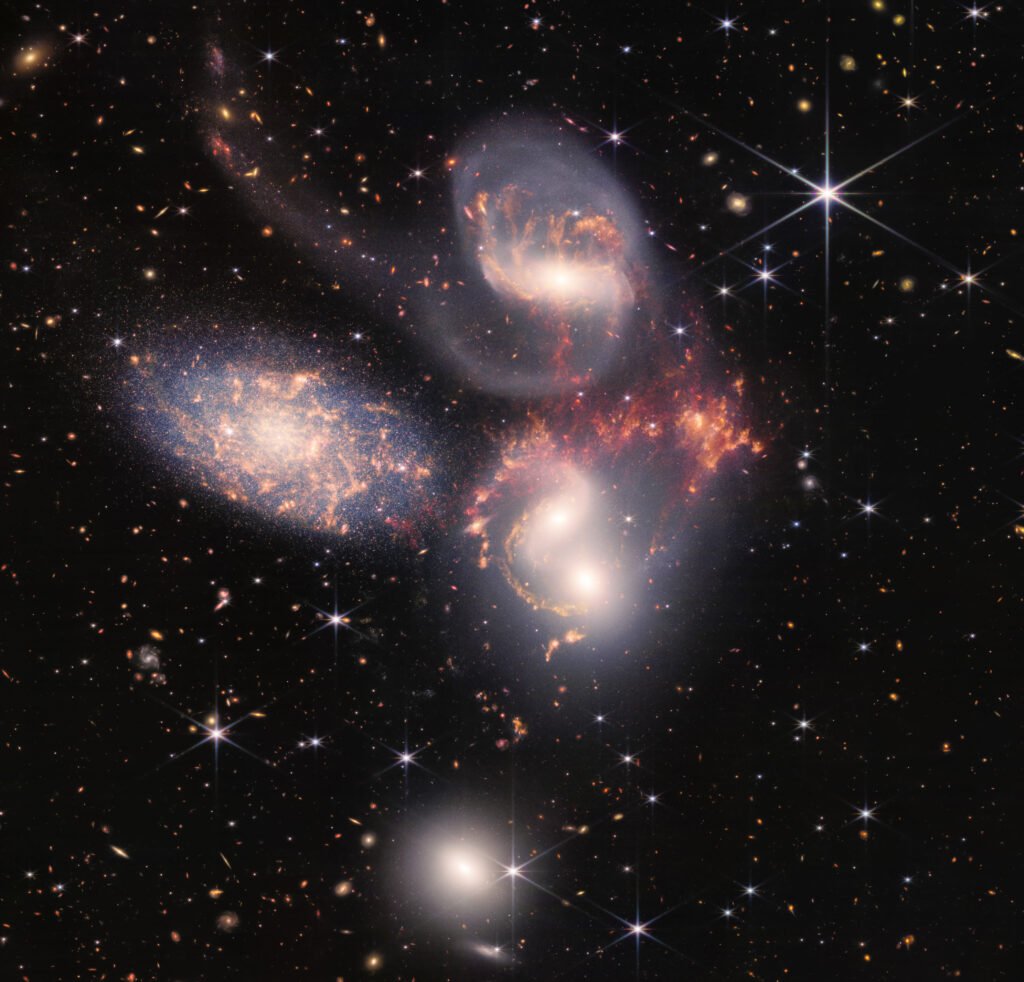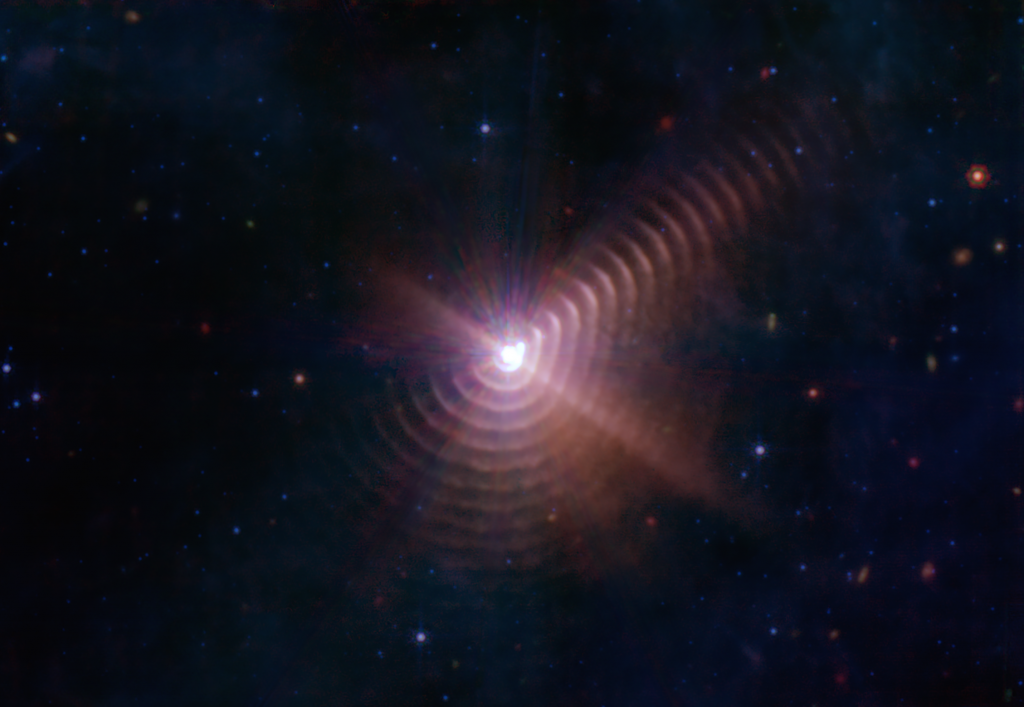James Webb Space Telescope – You might have seen the recent pictures from the James Webb Telescope, which is sweeping the internet in the past few weeks now. But if you are wondering what the hustle is all about, you have come to the right place.
This article includes all the info about NASA’s James Webb Space Telescope, mesmerizing videos and pictures captured by this great technology, and related FAQs answered. I’ve saved the most recent images for last!! Keep reading.
WHAT IS JAMES WEBB SPACE TELESCOPE?
James Webb Space Telescope (JWST) is an infrared space observatory, which was sent into orbit on December 25, 2021, and is the largest, most potent space scientific observatory from NASA. It is one of NASA’s Great Observatories – a collection of enormous space telescopes that can look far into space.
The $10bn James Webb Space Telescope, was sent out to explore the cosmos. To learn more about the evolution of the universe from the Big Bang to the birth of extraterrestrial planets, and beyond.
The Journey
The JWST traveled over a million miles (1.5 million kilometers) to a Lagrange point (a gravitationally stable place in space) over the course of 30 days. On January 24, 2022, the telescope reached L2, the 2nd Sun-Earth Lagrange point, a location in space close to Earth that is opposite the sun.
This orbit enabled the telescope to remain in line with Earth as it travels around the Sun. Other space telescopes like Herschel Space Telescope and Planck Space Observatory have also found it a useful location. Here is a video for you explaining its orbit.
ITS PURPOSE
#1 First light and Reionization – This is the period of time immediately following the Big Bang when the universe as we know it today first began. The light was not seen until the cosmos cooled down sufficiently for these particles to start merging in the early moments following the Big Bang when it was composed of a sea of elementary particles. This refers to the time when inert hydrogen was reionized by radiation from these earliest stars, is another topic that JWST will investigate.
Also read – From Zip2 to SpaceX: All about Elon Musk companies
#2 Assembly of Galaxies – One of JWST’s objectives is to look back at the oldest galaxies to better understand how the spiral and elliptical galaxies developed from various shapes over billions of years.
#3 Birth of Stars and Protoplanetary Systems – Stars form in gas clouds, and as they get bigger, their radiation pressure drives the gas away that was surrounding them. However, looking into the gas is challenging. JWST’s infrared vision will be able to detect heat sources, such as stars developing in these star-forming cocoons.
#4 Planets and Origins of Life – Numerous exoplanets have been found in the last decade, including ones using NASA’s planet-hunting Kepler Space Telescope. JWST’s robust sensors will be able to take a closer look at these planets, possibly even imaging their atmospheres in certain cases. Scientists may be better able to anticipate whether or not a particular planet is habitable if they have a better understanding of the atmospheres and conditions under which planets arise.
HOW DOES THE JAMES WEBB TELESCOPE WORK?

IMAGES FROM JWST EXPLAINED
#1 WEBB’S FIRST DEEP FIELD
The James Webb Space Telescope has created the most detailed and precise infrared image of the far reaches of the cosmos to date. This incredibly detailed image of the galaxy cluster SMACS 0723 is known as Webb’s First Deep Field. Webb’s perspective has seen the first appearance of thousands of galaxies, including the infrared universe’s weakest objects. This is a small portion of the huge cosmos, about the size of a sand grain, held out at arm’s length.

This deep field was captured by Webb’s Near-Infrared Camera (NIRCam), which combined images collected at various wavelengths over the course of 12.5 hours. This allowed for infrared depths that were greater than those reached by the Hubble Space Telescope’s deepest fields, which took weeks to capture.
#2 SOUTHERN RING NEBULA

The Southern Ring Nebula, also known as NGC 3132, is a planetary nebula that was recently photographed by two cameras on board the Webb space telescope. It is 2,500 light-years away, roughly. For the first time, NASA’s James Webb Space Telescope has shown that the fainter star at the center of this image, is shrouded in dust. This star has been ejecting rings of gas and dust in all directions for millions of years.
POSTS YOU DON’T WANT TO MISS
#3 STEPHAN’S QUINTET

The holiday classic movie “It’s a Wonderful Life” has a scene that prominently features Stephan’s Quintet, a visual collection of five galaxies. Today, a new perspective on Stephan’s Quintet is provided by NASA’s James Webb Space Telescope. Webb’s greatest photograph to date, this massive mosaic, spans nearly one-fifth of the Moon’s diameter. It is made up of about 1,000 different image files and has over 150 million pixels. The data from Webb offer fresh perspectives on how galaxy evolution may have been influenced by galactic interactions in the early cosmos.
#4 COSMIC CLIFFS IN CARINA

The edge of the neighbouring, young star-forming area NGC 3324 in the Carina Nebula may be seen as the scenery of “mountains” and “valleys,” which are dotted with sparkling stars. This image captured by JWST makes previously hidden zones of star birth now visible. Webb’s allegedly 3D image, known as the Cosmic Cliffs, depicts what appear to be rocky mountains on a moonlit night.
The largest ‘peaks’ in this image are actually the boundary of the enormous, gaseous cavity within NGC 3324 which are around 7 light-years high. Strong UV radiation and cosmic winds from extraordinarily large, hot, young stars located in the heart of the bubble, above the region visible in this view, have carved the cavernous area from the nebula.
Also read – What makes SpaceX and ISRO stand out from other Space Agencies?
JAMES WEBB LATEST PICTURES – JWST IMAGES
#5 PILLARS OF CREATION
The Hubble Space Telescope’s first photograph of the Pillars of Creation in 1995 and it was one of the most commonly seen space photos at that time. Now, the James Webb Space Telescope can share even more of the magnificence that is the Pillars of Creation with the rest of the world. The picture of this cosmic nursery from 6,500 light years away in near-infrared reveals numerous new characteristics.
The crimson spots visible on the top pillar’s margins are young stars, barely a few hundred thousand years old. The red lava-like spots in the other pillars are hydrogen molecule ejections from still-forming stars. The image is eight light years across but only covers a small portion of the Eagle Nebula.

Below is a comparison of images where the image on the left was taken by the Hubble Space Telescope in 2014, whereas the image on the right was taken by the James Webb Space Telescope.

#6 Dust Rings Around Binary Stars
The James Webb Space Telescope captured images of a system containing two huge stars, each 25-30 times more massive than our Sun. Their orbits, known as Wolf-Rayet 140, bring them close together roughly every eight years. When this happens, gravitational forces create a massive dust cloud. Previous views from ground-based telescopes revealed two dust rings, but the new JWST image reveals at least 17.

#7 Tarantula Nebula

The Tarantula Nebula, shown in the image above, is 340 light years across. It introduces us to tens of thousands of previously unseen stars that were lost in the dust of Hubble’s perspective. The region produces news stars that appear pale blue. In case you’re looking for the nebula’s eight-legged creature, it appears to be a tarantula’s tunnel with silk around the entry, rather than the spider itself. The mid-infrared image from the Webb Telescope is also shown in the video below. Gases and cosmic dust give out a turquoise and purple hue. It’s gorgeous to us laypeople, but it adds even more data for astronomers.
#8 Neptune’s Rings
The James Webb Space Telescope has taken the most detailed image of Neptune’s ring in over 30 years. We can see the rings as well as the planet’s fainter dust bands. Below is a comparison of Neptune taken from the three different telescopes.

FAQs
Q. How did JSWT get its name?
A. The telescope is named after James E. Webb (1906–1992), the second administrator of NASA. Webb is best known for leading Apollo, a series of lunar exploration programs that landed the first humans on the Moon. The James Webb Space Telescope was originally called the “Next Generation Space Telescope,” or NGST, but on 10 September 2002, it was renamed in honor of James E. Webb.
Q. What can we learn from Webb’s mission?
A. We have yet to observe the era of our universe’s history when galaxies began to form. We can’t see inside dust clouds with high resolution, where stars and planets are being born nearby, but Webb will be able to do just that. Additionally, using Webb’s advanced technologies, humans hope to learn more about dark matter, dark energy, black holes, and nearby hospitable planets, if any.
And then, there are the surprises we can’t imagine!
Q. What next and how long will the Webb mission last?
A. Webb’s mission lifetime after launch is designed to be at least 5½ years and could last longer than 10 years. The lifetime is limited by the amount of fuel used for maintaining the orbit, and by the possibility that Webb’s components will degrade over time in the harsh environment of space.
Q. Why is Webb an infrared telescope?
A. By viewing the universe at infrared wavelengths with such sensitivity, Webb will show us things never before seen by any other telescope. For example, it is only at infrared wavelengths that we can see the first stars and galaxies forming after the Big Bang. And it is with infrared light that we can see stars and planetary systems forming inside clouds of dust, which are opaque to visible light.
Q. How far back can James Webb Telescope see?
A. Webb will be able to see what the universe looked like around a quarter of a billion years (possibly back to 100 million years) after the Big Bang when the first stars and galaxies started to form.
Q. Will Webb image objects in our solar system?
A. Yes! Webb will be able to observe the planets at or beyond the orbit of Mars, satellites, comets, asteroids, and objects in the distant, icy Kuiper Belt. Many important molecules, pieces of ice, and minerals have strong characteristic signatures at the wavelengths Webb can observe.
Q. Will Webb take amazing pictures like Hubble? Can Webb see visible light?
A. YES, Webb will take amazing pictures! We are going to be looking at things we’ve never seen before and looking at things we have seen before in completely new ways. The beauty and quality of an astronomical image depend on two things: the sharpness and the number of pixels in the camera. On both of these counts, Webb is very similar to, and in many ways better than, Hubble.
Q. How big is James Webb Space Telescope?
A. The most important size of a telescope is the diameter of the primary mirror, which is approximately 6.5 meters (21.3 ft) for Webb. This is about 2.75 times larger in diameter than Hubble, or about 6 times larger in area. The Webb has a mass of approximately 6,500 kg, with a weight of 14,300 lbs on Earth (in orbit, everything is weightless), a little more than half the mass of Hubble.
If you found this article interesting and would love to hear more about space adventures and technologies, subscribe to JUST A LIBRARY.
Stay tuned!! Stay updated!!






